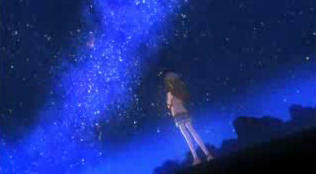
Since long time ago I wanted to write some detailed predictions based on what will happen in Heaven and on Earth from an astronomical point of view, I think it's a nice way to learn Chinese Astrology because maybe nowadays, with so many computers around us, we are missing the magic and inspiration that gives watching a starry night sky outside of a big city and its lights.
So, I decided to begin now in January 2015, this month will bring us many interesting things from the beginning, for example, between the 1st and 5th of January we could try to watch the meteor shower known as the Quadrantids, one of the most powerful and interesting of the year, even if they are sometimes called "star showers", actually they are not stars but fragments of asteroids and comets which hit the Earth while she goes round the Sun.
In this case, the Quadrantids are thought to be remains of an extinct comet which died 500 years ago, and some think they may be related to the Qingyang event (庆阳) occurred in China in the spring of 1490, in which, according to official records of the time, "countless stones fell from Heaven instantly killing tens of thousands of people and forcing many others to flee their cities"; some think this could be due to the explosion of a large asteroid (an extinct comet) in the atmosphere, which in turn would leave many fragments scattered throughout the space which would then cause this meteor shower every year.
Very interesting, but... this year will be difficult to see the Quadrantids because it coincides with the full Moon, which will cause the night sky to be too bright to see most falling stars, anyway, if you want to give it a try, the most active day should be January the 3rd.
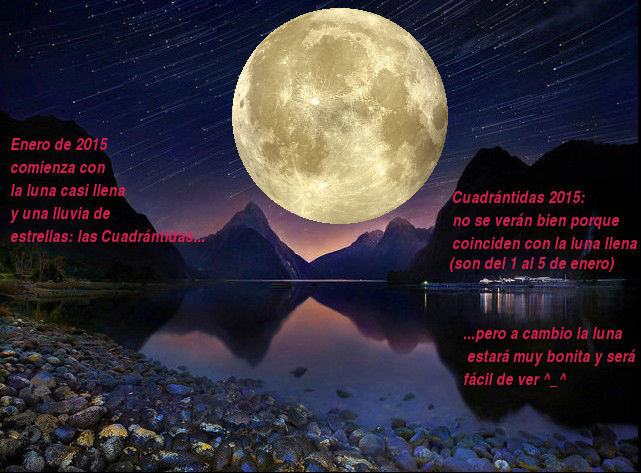
Apart from this, one very certain prediction is that as January passes by, the days will become larger in the Northern Hemisphere and shorter in the Southern Hemisphere, you may think this is too obvious a prediction, but is a clear example of how what happens on Heavens influence what happens on Earth, this kind of obvious relations is what gave birth to Chinese Astrology in ancient times.
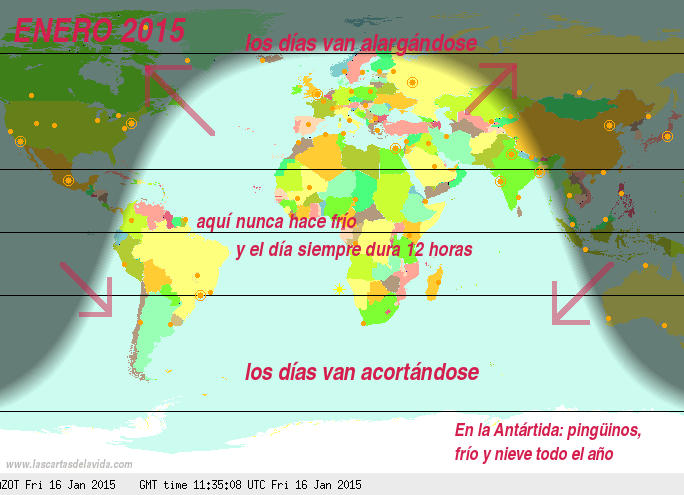
By the way, sorry for not translating the graphic annotations, I hadn't time for it, and anyway you are not missing anything important, just some bad jokes and other things already in the text.
Going back to Chinese Horoscope and Astrology, it's good to remember that although 2015 begins on January the 1st, according to the Chinese lunar calendar we are still in the Wood Horse year and the Rat's month, at least according to most astrologers, because there are different opinions regarding the beginning of the Astrological Chinese New Year, and for some the Wood Goat Year already started last December 22nd with the winter solstice.
Anyway, controversies set aside, the Moon will be full around day 5, and in those days you'll see it in the Chinese constellations of the three stars (Orion) and The Well, also sometimes called the Vermilion Bird head for being the first of seven constellations associated with this mythological bird; in this representation one would rather say it's the wingtip and not the head, it all depends on how you imagine the bird:
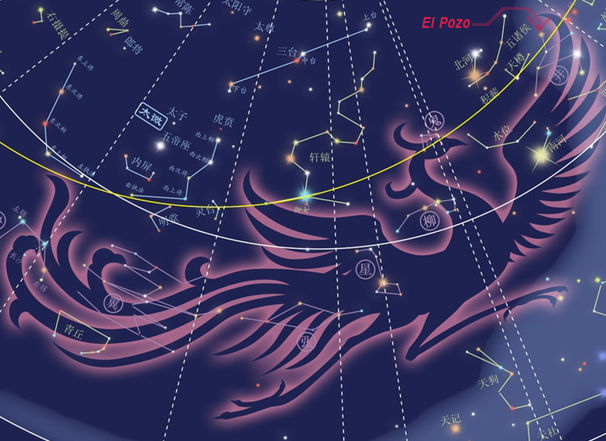
The Chinese character that represents the Well constellation, 井, is a drawing of the constellation itself, which is very typical in Chinese Astrology, and a good way to remember names at least in its written form, to pronounce them in Chinese is another story...
Here you can see the almost full Moon passing by Orion and heading to the constellations of the Red Bird from the South, it will go through all of the seven of them after January 3, 2015:
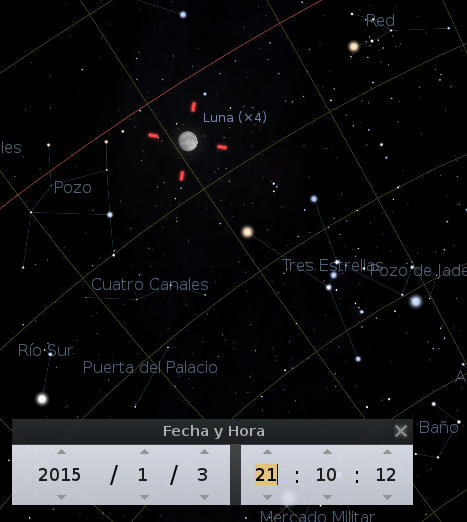
According to most authors, the meaning of Moon passing through these constellations is rather neutral or somewhat positive if one strives to do things well, but if you want a personalized prediction according to Chinese astrology it's better to use the programs I made for that: one for annual predictions and other for daily predictions.
It also happens than in early January the Sun will be in its closest position to Earth during 2015, exactly on January 4th, this is called perihelion, and the distance is about 147 million kilometers, which are few compared to the 152 of the aphelion in early July.
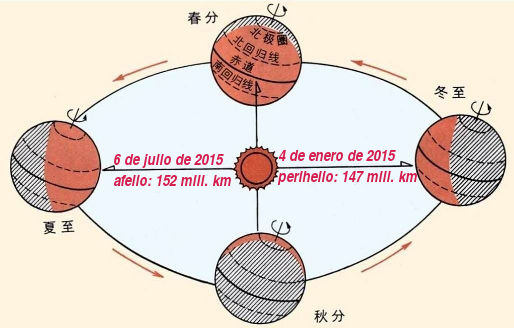
Shortly afterwards, on January the 6th, 2015, begins the Ox month according to Chinese Astrology, and that should bring positive influences in the sense of seriousness and well done work, at least for those who have a real desire of doing things this way, although quite interestingly this time will occur this special situation:
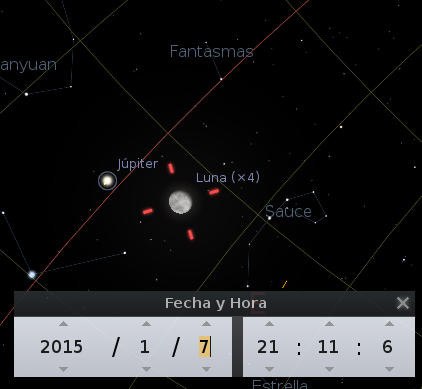
It turns out that at the time that begins the Ox month (defined by the position of the Sun), the Moon and Jupiter are together halfway between the constellation of the Willow and the Ghosts (also called the Ghost Carriage), which are both ominous, willows in China are related to the world of the dead, and its branches are usually carried in funeral processions for this reason, in fact it is said that the ghosts of the constellation next to the Willow are pollen from that willow that the Wind blew up there.
Moreover, the Chinese character for suffering is taken from the constellation of The Ghosts, and looks like this: 凶, which is nothing but the graphical representation of the constellation, the "box" represents the carriage, and in the middle the ghosts themselves, that although in the above image can not be seen, with a telescope you would notice that in the center of that carriage there is a kind of spectral cloud which is just the Praesepe (M44) nebula.
And as this nebula's photo is a bit dull, here you have a scene of a Kunqu opera well known in China and abroad, The Pavilion of Peonies, which portraits several willows and ghosts; the argument is basically a Love story where the girl dies and the boy has to stole her body from the cemetery to make her come back from the world of the dead and resuscitate her, it's a masterpiece worth seeing if you have a chance:
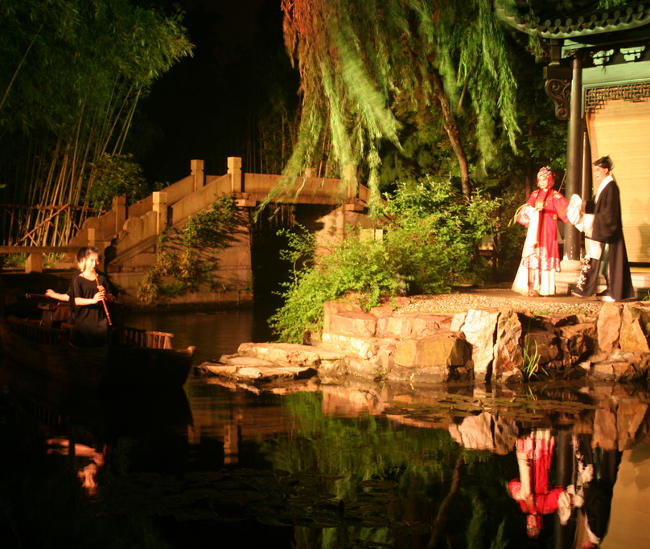
But back to the month of the Ox, it starts with bad omens, something like going through a scary funeral procession... but I guess the Ox, which is the most persistent sign of Chinese Zodiac, will overcome the situation and move forward. Traditionally it was said that these days are good for meditation and introspection.
After this, on January 20th 2015, the new Moon arrives, in this case it's the last one of the year of the Wood Horse and coincides that this day is almost the one in which the distance from the Earth to the Moon is the smallest (356,500 km, called perigee), while the Sun is also pretty close because having been the perihelion in early January, to which is added the fact that these are also the days of the midpoint of the Ox's month, when it's understood that its influence is greater.
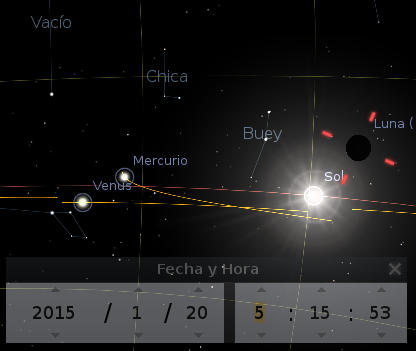
Thus it is expected that between 20 and 24 January Ox's influences are felt strongly, both for good and for bad, so these days should be very good to work seriously and in a constant way, but being careful to avoid too stubborn and intransigent attitudes.
And finally with the end of January comes the best part of the month: the eighth day of the last lunar month of the Chinese lunar calendar is the La-Ba festival, which this year falls on January 27th.
It's a celebration where it's typical to eat a kind of stew made of very different ways, both sweet and salty, and it basically comes to represent the joy and energy that gives a simple and nutritious meal after a period of scarcity and/or fasting, somewhat it's a way to acknowledge the simple but useful and valuable things in life.
In this photo they are serving the traditional version, which I understand is basically a stew made with red beans and no meat:
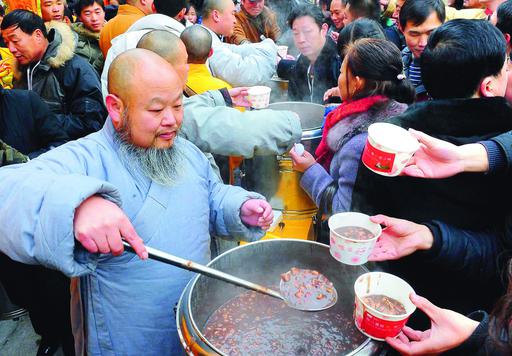
According to legend, this tradition arose because Buddha decided to fast to try to find the true enlightenment, and after many days of fasting, when he was already quite weak, he arrived to a village where a warm hearted girl invited him to eat a simple meal, some say it was a kind of rice pudding, others that it was a kind of stew like the previous photo; anyway, the fact is that he accepted the invitation and soon afterwards found the true enlightenment he was looking for, it is understood that in part thanks to the girl and the food that she gave to him, that despite being simple and humble, for him it had great value both at a physical and spiritual level.
It is also a celebration with a meaning of put hands to work, in the sense of eating and start working, in fact this festival was formerly associated with a ceremony where oxen were taken out of the barn to prepare them for plowing.
And so, with the crescent Moon we will be going into February, and then the Chinese Year of the Wood Goat will begin officially, exactly the February 19th 2015. See you then!

